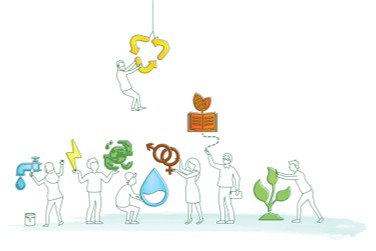Enterprise Profile
The main goal of this type of enterprise is the creation of meaningful impact for the most disadvantaged groups within the society, most of them being in rural areas. It is close to its end beneficiaries, engages the local community, and the solutions are built based on the needs of the community rather than a business opportunity.
Business Model Features
The enterprise has a diversified offering including both products and/or services, which aim to provide access, or secure/improve basic water-related services in hard-to-reach rural areas. It sells its offerings to all client types (B2C, B2B, B2G) but they benefit the end users and are based on what the communities require.
The enterprise usually aims at securing recurring revenue from their customers, while also relying on other strategies to retain them – for instance, through offering maintenance services to secure customer loyalty. The offerings take the form of products such as water filters as well as mobile or low-cost infrastructure for water purification and sanitation.
Context and Environment
This type of enterprise operates in rural areas of developing countries, where the needs for and potential impact of access to water is largest. It serves middle to lower-income customers and also marginalized or BoP communities, providing water related solutions such as clean drinking water and sanitation.
Impact Potential
Enterprises in this category offer effective water solutions to beneficiaries in rural areas, contributing to a more safe and sustainable water supply for the lower income and marginalized groups. The solutions are often based on what the beneficiary group needs, and is paired with activities engaging and educating the local community, legislation, and other stakeholder groups.
Potentially relevant SDG Targets
Water-related impact
SDG 6.1 By 2030, achieve universal and equitable access to safe and affordable drinking water for all.
SDG 6.2 By 2030, achieve access to adequate and equitable sanitation and hygiene for all and end open defecation, paying special attention to the needs of women and girls and those in vulnerable situations.
SDG 6.3 By 2030, improve water quality by reducing pollution, eliminating dumping and minimizing release of hazardous chemicals and materials, halving the proportion of untreated wastewater and substantially increasing recycling and safe reuse globally.
SDG 6.b Support and strengthen the participation of local communities in improving water and sanitation management.
Similarly, entrepreneurs could focus on areas in waste management or agriculture where high impact can be achieved by overcoming barriers rural end-customers face.
Social impact
SDG 5.5 Ensure women’s full and effective participation and equal opportunities for leadership at all levels of decision-making in political, economic and public life
SDG 8.5 By 2030, achieve full and productive employment and decent work for all women and men, including for young people and persons with disabilities, and equal pay for work of equal value.
SDG 8.6 By 2020, substantially reduce the proportion of youth not in employment, education or training
SDG 8.8 Protect labour rights and promote safe and secure working environments for all workers, including migrant workers, in particular women migrants, and those in precarious employment
Team and Experience
While being a rather young, the enterprise worked and refined its business model over several years. The team has technical expertise and also invested in R&D of the product and services. Production expertise is less relevant if the enterprise provides existing technologies and solutions.
At this stage, many teams lack professional experience in finance and marketing/sales, which might be required at a later stage to access further funding and reaching potential customers.
Financial Profile
Enterprises in this typology commonly offer products and services that are based on existing technologies, indicating lower capital expenditure requirements. The business model is rather easy to replicate, but since the enterprise is operating in rural areas, the competition is also low.
The enterprise cannot raise its price significantly due to its target and might have high operational costs to reach the rural areas. This makes it a rather difficult environment to operate and explains the low revenue.
Nevertheless, by offering related products or services, the business might be able to build loyalty and attract new customers. Part of the offerings can be scaled into more commercially viable businesses through product innovation or implementing a franchise model, which can attract more commercial financing.
Partnering with micro-finance institutions or banks that provide end-user financing can be another important strategy to extend the business’ customer base.
What are your Financing Options?
Grant and Results-based Finance (Impact bond, SIINC, performance-based loan, performance-based contract)
Enterprises operating in rural areas and creating meaningful impact for lower-income groups and other marginalised communities are likely to fulfil the requirements for grant funding. Yet, it is important to provide a clear theory of change on what impact will be achieved and who will benefit from it.
In order to receive results-based financing, the enterprise would need to demonstrate a clear way of measuring impact, in addition to its theory of change. This is oftentimes more fitting for enterprises that have a running operation (seed stage) than those who are still experimenting with their model (often pre-seed stage).
Some of the results-based financing options require further indicators on the financial viability of the enterprise such as for the performance-based loan or SIINC, as it needs to demonstrate its ability to service the loan or raise equity.


